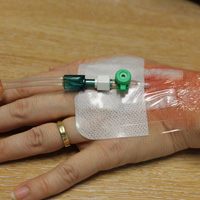Ointment therapy and prevention of cannulation-induced superficial phlebitis

Accepted: 22 May 2021
HTML: 93
All claims expressed in this article are solely those of the authors and do not necessarily represent those of their affiliated organizations, or those of the publisher, the editors and the reviewers. Any product that may be evaluated in this article or claim that may be made by its manufacturer is not guaranteed or endorsed by the publisher.
Authors
The primary aim of this prospective randomized trial is to determine the effect of clobetasol ointment with nitroglycerin ointment on the prevention of phlebitis caused by cannulation. The target sample is 144 patients admitted to surgical ward, randomized to 3 groups. the data collection tools included demographic information, information about intravenous treatment and phlebitis measurement scale. In the intervention groups, after venipuncture, 1.5 cm of ointments (clobetasol and nitroglycerin) was applied n three time periods of 24, 48 and 72 hours from the time of venipuncture. In the first 24 hours after cannulation, there was no significant difference between the three groups. But at 48 and 72 hours after placement, the difference between intervention and control groups was significant (P<0.0001). It is recommended to use clobetasol ointment and nitroglycerin ointment to prevent the occurrence of phlebitis in patients who need long-term use of cannula (more than 48 hours).
How to Cite

This work is licensed under a Creative Commons Attribution-NonCommercial 4.0 International License.
PAGEPress has chosen to apply the Creative Commons Attribution NonCommercial 4.0 International License (CC BY-NC 4.0) to all manuscripts to be published.

 https://doi.org/10.4081/vl.2021.9800
https://doi.org/10.4081/vl.2021.9800





